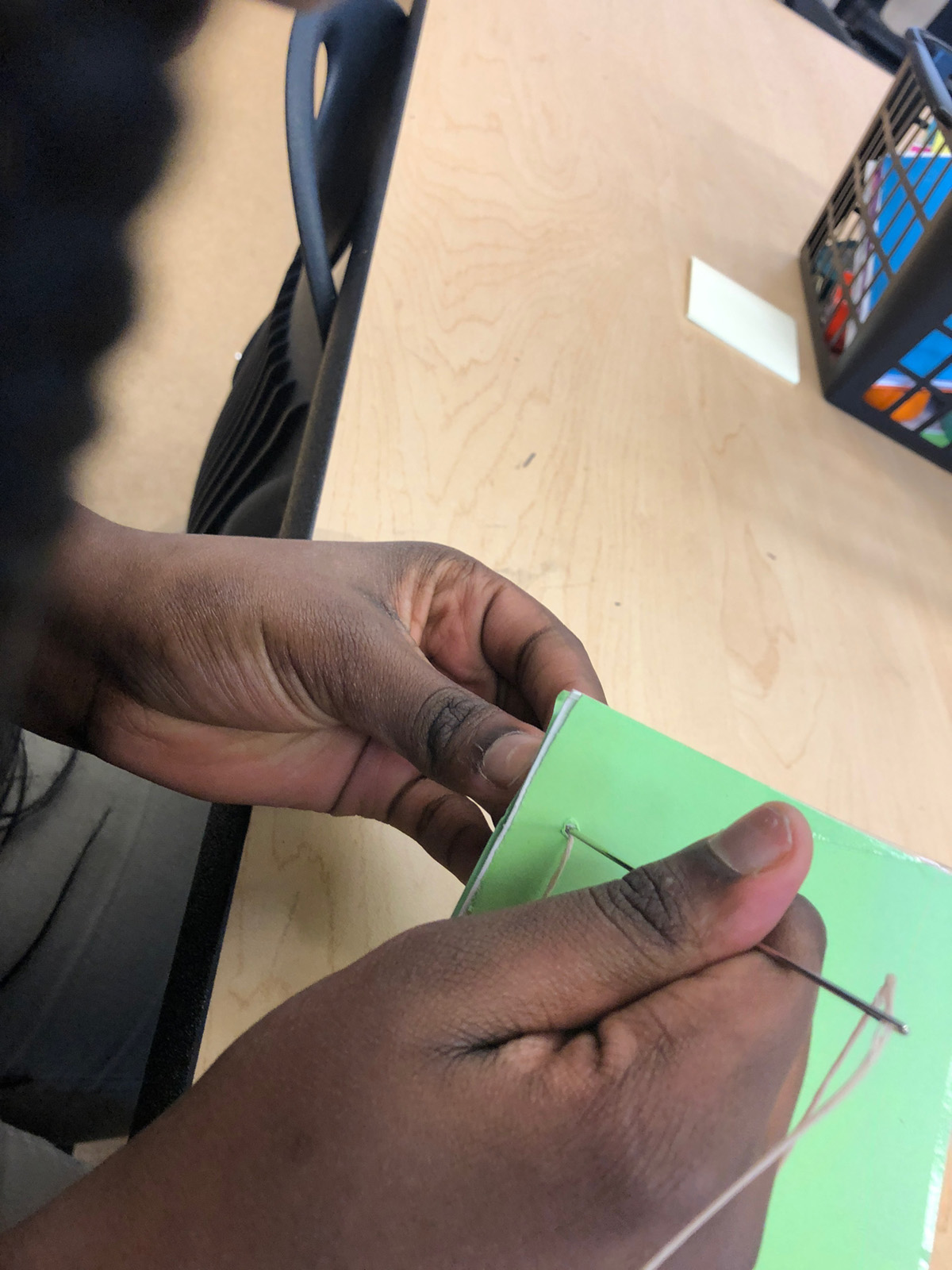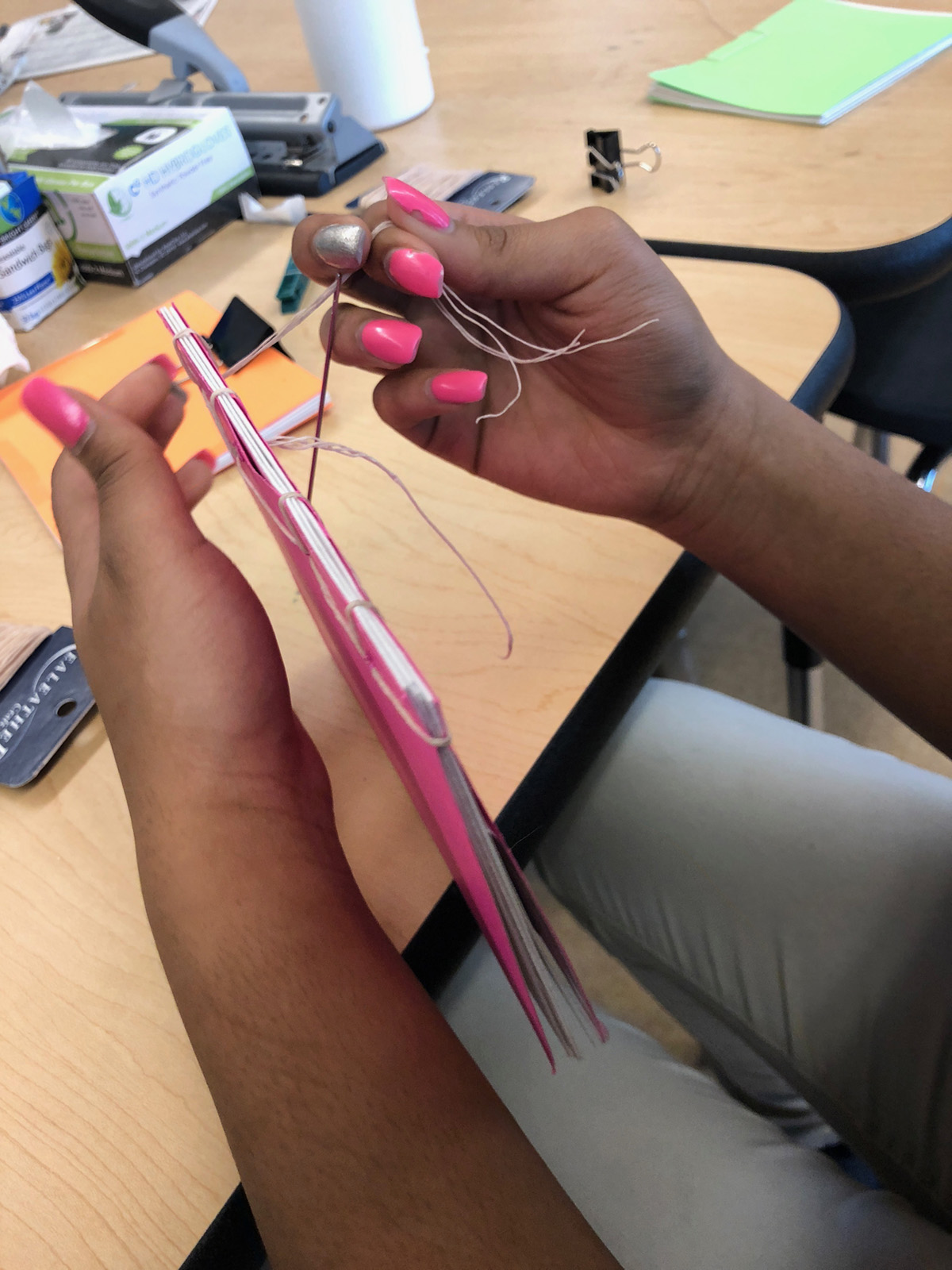Be The Change
By Alicia Jean

Students in the 8th grade Visual Art course at STEM Magnet Academy visited the MCA to study the work of Takashi Murakami. Students honed in on the idea of an arhat who has attained spiritual enlightenment, and worked on inquiries through artmaking to explore a path to peace from struggle through community connections.
GOALS
- Students will be able to identify areas of “struggle” in everyday life
- Students will examine ways contemporary artists respond to “struggle”
- Students will use artmaking to alleviate struggle through community connection
GUIDING QUESTIONS
- What worries you?
- What do you do to cope with stress/pain?
- How can we help those in our community to better cope with stressful situations?

Documentation + Assessment Strategies
We decided to document the process by taking photographs of the various stages. We also view the books as documentation. The hope is to see the books returned and to put them on display in the school. Other than self-reflection forms, we decided to not formally ‘grade’ this project.
Learning Activities
STEP 1
Introducing Arhats
The teacher begins by showing images of the Arhats in Murakami’s paintings. Students are invited to share their initial reactions to the Arhats. Students describe what they see, what they feel, what the images and colors remind them of, and so forth.
STEP 2
Contextualizing Arhats as Represented by an Artist with Purpose
The teacher screens the MCA video on Takashi Murakami in class. She leads an interactive dialogue comparing and contrasting the video with existing knowledge about images by Murakami.
STEP 3
Guiding Questions Discussion
The teacher presents guiding questions on slides and leads a grand discussion.
- What worries you?
- What do you do to cope with stress/pain?
- How can we help those in our community to better cope with stressful situations?
The teacher records short answer examples of worries, and then expands to a full group discussion about these issues. The teacher then leads students to questions connecting to Murakami:
- How would you feel if you had your own personal Arhat?
- How can we be Arhats for others?
STEP 4
Visiting the MCA
Students are taken on an artist-led tour of the MCA. Students have the opportunity to view the works that were previously discussed in class (Murakami). After the tour, students share the new information that they learned about Murakami and discuss their take on his work.
STEP 5
Collective Brainstorming for the Studio Project
Students gather in small groups to brainstorm ideas for the socially engaged studio project that would spread hope throughout their community. Each group has access to technology, but develops their own authentic ideas to share with the class. After 20 minutes of brainstorming, students gather in a large group and share their thoughts. This discussion leads to an informal vote on which project would reach the greatest number of people. The class vote overwhelmingly indicates that the students desire to make a traveling mandala book that is passed along to people in the community.
STEP 6
Book Factory
Students produce books collectively in an assembly-style rotation. Each book contains directions and encourages the temporary owner to write down their problems or worries, then place them in the pocket in the back of the book.
STEP 7
Arhat Books in Action
Students now take each of the developed books and begin the process of spreading hope by becoming the first temporary owners of the books. They begin the process of writing down their worries and problems on a post-it note and place the note in the back pocket of the book. For uniformity, students create mandalas on the first page of each book. A quote or message of hope can be added to accompany the mandala. Once completed, students pass along the book to anyone in need of a ‘pick-me-up’ and the cycle continues with the new owner. The users are encouraged to document their experience with the book on Instagram using the hashtag #bethechangeSTEM.


Materials
- Murakami Presentation
- Projector/smartboard for presentation (otherwise print out copies of the presentation)
- Scissors
- Bone folder
- Three sheets of 18 x 24-inch (approximately 46 x 61-centimeter) drawing paper or sketchbook paper
- Sheet of thick handmade paper or card stock
- Waxed linen thread
- Bookbinding needle
- Awl
- Ruler
- Triangle, or set square
- X-Acto knife, or craft knife
- Printer paper for directions and back pocket
- Compass
- Protractor
MCA Connections
The museum served as a catalyst for this project. Murakami’s Arhats served as the primary focus prior to beginning the project. Initially we viewed slides of the panels that contained Arhats. We then discussed the meaning behind the Arhats and viewed the MCA Murakami video. The idea of the Arhats being figures of protection led to the project development. The students brainstormed how to be an Arhat for themselves and the people in their community. The field trip fit nicely into the project because the students were able to see the artwork that we had previously viewed in class and discussed.
References + Resources
Alicia Jean
STEM Magnet Academy
About Alicia Jean
Alicia Jean began her teaching career in 2008. She is a proud graduate of DePaul University, where she earned her undergraduate degree in Elementary Education with a concentration in Art. She earned her graduate degree in Technology in Education at National Louis University. Alicia taught 3rd grade and 5th grade at CICS Longwood Academy. She also organized the elementary athletic program at Longwood, in addition to coaching Track and Field.
Alicia currently teaches at STEM Magnet Academy. She began her journey at STEM as a 4th grade teacher and transitioned to teaching 6th grade with a primary focus on mathematics. In 2017 Alicia became the middle school Visual Art and Technology teacher at STEM. Her passion lies at the intersection of art and tech; she is thrilled to be able to teach both. In her spare time, Alicia enjoys designing tee shirts in her at-home studio, in addition to maintaining an active lifestyle while biking, backpacking, and playing football.
Alicia Reflects on the Project
One hallelujah moment happened the day that I realized my students were collaborating and working without my assistance. Once they understood the steps and decided who would contribute to which aspect of the project, they took ownership of the project. This was a beautiful sight to see. An obstacle that I encountered involved engaging two students that had no interest in participating in the project. If I were to start this project over I would put forth much more effort trying to help these students make personal connections with the project. There was much buy-in from the other students in the class; I needed to help these two see how powerful these books could potentially be. Many of my students continued the conversation of positively impacting strangers within their community. They loved the thought of being able to help people with a variety of issues without even knowing them. We discussed this, and also how to handle the situation in which the books do not resonate with people.